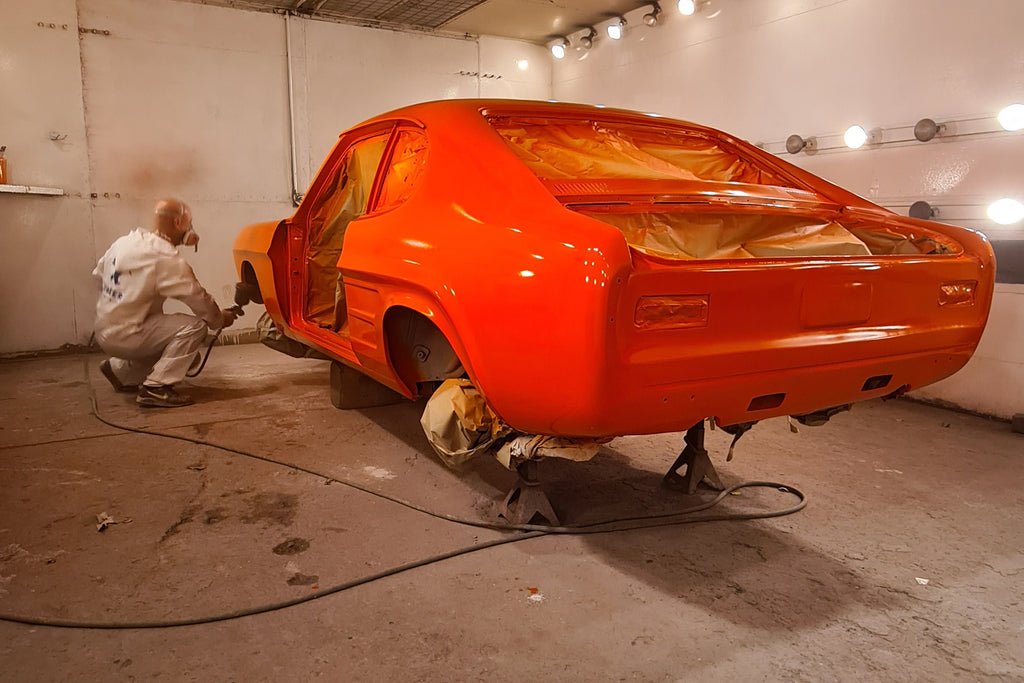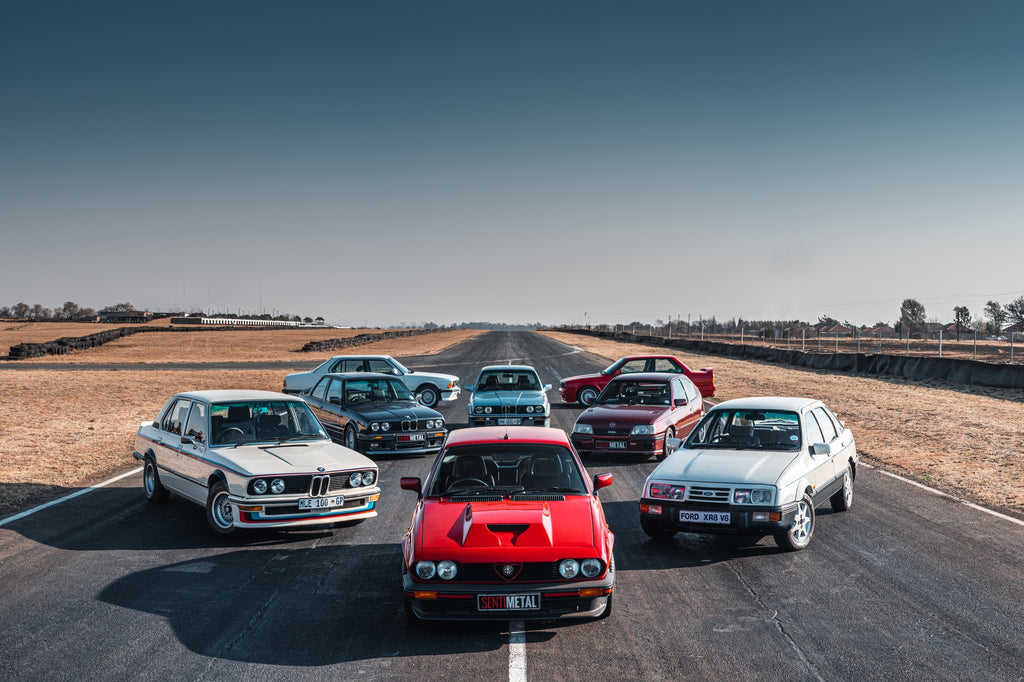This Heritage Day we celebrate the era that gave us South Arica's most special and sought-after cars. And possibly for the first time in the modern era, we got eight of them together for a glorious photoshoot at Midvaal.
Image Credits: Roarke Bouffe, Stefan Kotze (Perana restoration)
South Africa has always punched above its weight when it comes to the automotive industry. It has given the world great car and motorbike designers such as Gordon Murray (McLaren F1), Keith Helfet (Jaguar XJ220) and Pierre Terblanche (Ducati), a Formula 1 champion (Jody Scheckter) and a surprising number of F1 designers/technicians, of whom Rory Byrne (Toleman, Benetton, Ferrari) is by far the most well-known. More recently Brad Binder (MotoGP) and the Van der Linde (DTM) brothers joined the long list of names of South Africans to achieve international motorsport success.

The country’s fascination with motorsport significantly predates the cars that are the focus of this particular article. Even the few serious efforts that were made to develop and sell a “South African” car prioritised motorsport success - for example the Protea and GSM Dart from the late ‘50s. Back then the skills and “can do” attitude so typical of South Africa, were on display.
Motorsport ignites the fire
In the ‘60s and ‘70s, however, motorsport in South Africa evolved into serious business, with most of the major brands using the sport as a platform to market their vehicles. South Africans love the gladiatorial aspect of sport, whether it’s rugby, soccer or boxing. It feeds on the narrative of heroes and villains. And during the ‘60s and ‘70s in particular, no sport better allowed for this escapism than motor racing. So the country’s various racing circuits attracted big crowds, and major sponsors followed. The era of professional motorsport had arrived and the car brands were all in. What followed were three decades of intense rivalry, between brands, between teams, between drivers and a fan base split into their respective brand “camps”.

For a while, it was a titanic Ford vs Chevrolet duel that kept the fans on their feet in the grandstands. And it was really in this period that the “South African Special” was born. Cars like the fast-appreciating Ford Capri Perana and Chevrolet Firenza Can-Am would never have existed if it wasn’t for motorsport.
From the mid-’70s and onwards to the start of the ‘90s, a staggering number of South African Specials were produced as brands attempted to remain at the sharp end of the grid in whatever class they were competing in. But it wasn’t only competition that was driving this “arms race”, it was also born from necessity. South Africa is a right-hand drive market, and during the ‘80s in particular, an increasing number of high-performance cars simply weren’t available in right-hand drive (the BMW E30 M3, for example). Also, with the country’s currency, the Rand, imploding, coupled with high import taxes, the ability to source imported cars that could win races was very much diminished. That’s how, in 1986, the ridiculous situation where an imported Mercedes-Benz 190E 2.3-16 cost more than three times the price of a locally built BMW 333i (South Africa’s E30 M3 alternative) happened.

So, the saying that “local is lekker”, translated as “local is great (or delicious, strictly speaking)”, certainly held true, in automotive terms, in the ‘80s in particular.
From Group 1 to Group N
Group 1 was the most popular racing series at the time, and it called for a limited number of cars to be built for public consumption before a vehicle could race. Fiat developed the 131 Racing, using various trick bits from Lancia and Abarth, as an example. Ford evolved its ageing Cortina into the XR6 Interceptor, a racy number limited to 250 units that featured triple-downdraft 42 Weber carburettors, an aggressive camshaft, a different exhaust manifold and suspension updates. Add the legendary Sarel van der Merwe behind the wheel and you had a winning, marketing-friendly, recipe.
The pace of development in Group 1 was frenetic. As soon as one brand gained the upper hand, the other would hit back with an improved, or entirely different model, unseen anywhere else in the world. This is how these uniquely South African cars were born… in the heat of battle, often using the best pieces that were available in parts bins from around the world, but always ultimately dreamed-up, developed, tested and built, in South Africa.

During the ‘80s, under increasing political pressure, several brands left South Africa (Renault, General Motors and Alfa Romeo, notably), but those that stayed invested even more in the “South Africanising” of their product line-ups, and still believed in motorsport as a marketing platform. The Group 1 war continued, but the cost of winning kept escalating, and by around 1985 the signs were clear that Group 1 was doomed. How do you respond to something like the BMW 745i, for example. How do you do better than the Ford Sierra XR8? A reset was required.

Enter Group N, ostensibly a more affordable series, formulated to attract cars that were more closely related to the vehicles you could afford on dealership floors. Even while Group 1 was still in full swing, Group N was growing in popularity, with cars such as the locally manufactured Volkswagen Golf and Opel Kadett, and a new generation of drivers battling it out for the spoils. On the other end of the spectrum, the WesBank Modifieds series also gained traction, and generally featured monstrously powerful, heavily modified versions of the cars that used to do battle in Group 1 (such as the BMW 745i and Ford Sierra XR8). The country’s best drivers usually competed in both series and, for once, it seemed like South African motorsport had struck a perfect balance between affordability and unadulterated action.

But as with Group 1 that preceded it, Group N (and WesBank Modifieds) quickly became an expensive arms race itself, driven by two brands, BMW and Opel, now under the auspices of Delta Motor Corporation, after General Motors had left the country. Lead drivers Tony Viana and Michael (Mike) Briggs were the stars and the respective brands’ poster heroes. For BMW in particular, having an upstart brand such as Opel challenging its status, was a bitter pill to swallow. Down in Port Elizabeth, Delta Motor Corporation lived and breathed motorsport in that period. Following the GM withdrawal it knew it had to convince the SA public that it was there to stay, and more South African than ever before. Motorsport success was the key.

And so started the last “spurt” of the South African Specials era. Rolf Mentzel, the father of the Opel Kadett “Superboss” will quickly correct you and point out that the ultimate Kadett was in fact not developed to beat BMW, but rather to counter a secret new fast Golf GTI being developed in nearby Uitenhage, the so-called “Spitze”. This Golf was supposedly going to annihilate the “Big Boss” Kadett, but when Delta caught wind of the Spitze, development started immediately on the Superboss, in secret.

Meanwhile, BMW was trying its level best to defeat the “Big Boss” Kadett GSi, and rolled out the E30 325iS Evo 1, only to be caught by surprise when Opel unleashed the Superboss, as was Volkswagen, which soon after cancelled the Spitze project. The Superboss had the measure of the Evo 1, according to Opel driver Mike Briggs, but when the Evo 2 emerged, the pendulum swung back BMW’s way. Sadly, for BMW, its lead driver Tony Viana was battling cancer by 1992 and so Briggs took that championship, too.

With South Africa part of the global community again by the early- to mid-’90s, the focus shifted towards the more internationally-oriented Super Touring Car championship from 1993 onwards, sounding the death knell for Group N and the era of the South African Special. We’ll never see the likes of it, and the cars that it produced, again.
South African Specials Today
Interest in uniquely South African cars is growing rapidly in the greater, international classic car community. Of course, this means that values are also skyrocketing on most of these vehicles.

But there’s a lot of education that still needs to be done, and the stories need to be retold to new car fanatics to make sure that this automotive heritage is protected. That is why we, as Cars.co.za started the SentiMETAL project initially, to make sure we play our part in preserving this history.
Cars.co.za’s own collection of uniquely South African cars currently includes an Alfa Romeo GTV6 3.0, Opel Kadett GSi Superboss, Ford Capri Perana and both a BMW 325is Evo 1 and Evo 2. We recently had the opportunity to bring some other icons together for a massive photoshoot at Midvaal in Gauteng. It wouldn’t surprise me if it was the first time that these particular SA Specials were photographed together in the modern era.

Joining the SentiMETAL fleet (excluding the still-to-be-completed Perana), were a pristine BMW 333i (essentially South Africa’s E30 “M3”), the incredibly rare BMW 530 MLE, an automatic 745i (famous for sporting the same engine as the M1 supercar) and also a rumbling Mustang-engined Ford Sierra XR8.”
The SentiMETAL Ford Capri Perana
Developed locally by Motorsport legend Basil Green, and with full Ford factory support, the Perana is the only Capri V8 in the world that carried Ford's official blessing. It was, of course, developed with motorsport very much in mind and its 5.0L V8 certainly made a wonderful noise. Cars.co.za acquired a rare Peri-Peri red automatic Perana two years ago, and restoration on this vehicle is currently nearing completion.

Paintwork has been completed, and now starts the tedious and detailed process of assembly. As was the case with Cars.co.za’s other restorations, the project is managed by Basie Theron (Algadine Panelbeaters) and Werner Meyer (who also restored the SentiMETAL Superboss).
We hope to reveal the Perana to South Africa before the end of the year, and plan to offer the public the opportunity to get reacquainted with the iconic Ford in various ways. Stay tuned!


So why weren’t Mark and Gavin Cronje mentioned for their accomplishments, le man’s cup, world cup Karting, they are a team to recon with…. The depth of SA motorsport, the accomplishments of the development of the Gtv3ltr that just blasted the BMW, the small 2wd rally Car that could run with the 2000 4wd class at the hands of Mark, and the Le man’s cup that Gavin won in 2009, They really never get the mention they deserve for their talent.